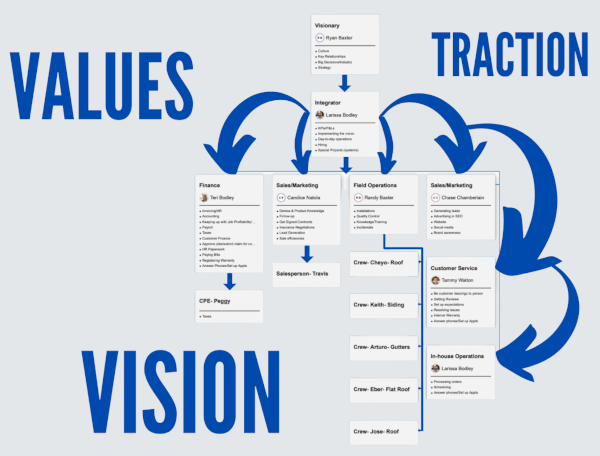Now that you’ve practiced EOS at the leadership level and are ready to deploy to the rest of your team, how do you introduce it?
So, you’ve started using the Entrepreneurial Operating System® (EOS®) to achieve Business by Design. It’s an excellent decision that results in better processes and accountability, aligned team members, and a business that can eventually run with a culture of transparency and accountability. But how do you effectively introduce the concepts and tools to the rest of your team?
EOS is a system that should be applied consistently and methodically to reap the greatest benefits—and rolling it out within a company is no exception. Here are some best practices for doing it well:
Three stages along the best timeline
People learn things and apply that knowledge better when they receive information incrementally, as dropping too many concepts at once can be overwhelming.
This is why a company-wide EOS rollout is often done in three distinct stages over three consecutive quarters (and additional ones, if necessary). Some companies choose to conduct all these stages at once, but we don’t recommend it. While it’s possible to succeed with this rushed approach, doing so lowers the odds of a team genuinely understanding and engaging with the system the same way you did: through spatial learning, so you can learn through practice and experience.
It’s important to note that every business is different, and the best practices below are what generally work for most. But remember, your company and values are unique. So, make sure you understand the purpose of each of these phases to “make the shoe fit” your organization.
Nevertheless, quarterly is a pace we’ve seen achieve great results. In any case, leaders will start the process after practicing these concepts with an EOS Implementer(™) and thus will be well-versed enough to bring these elements back to the team.
The three stages we suggest are:
- The Vision Rollout
- The Quarterly State of the Company Meeting Rollout
- The Foundational Tools Rollout
Let’s dive into each stage:
Introduction Phase 1: The Vision Rollout
Introducing the Vision and its elements to your team happens after you’ve completed Vision-Building Days 1 and 2. At this point, the company’s Vision is solidified, and the leadership team has answered the eight crucial questions to define Core Values, a Core Focus, a Core Target, a marketing strategy, the 3-Year Picture, the 1-Year Goals, the Rocks for this quarter, and the Issues we need to fix long term.
At this point, it’s time to bring the rest of the team together and announce that you’ve been using/practicing EOS for the last few months. We should explain what EOS is and dive into the eight questions that are part of the Vision/Traction Organizer™ (V/TO™).
Some companies provide team members with a simplified version of the book Traction: Get a Grip on Your Business before this meeting, so they understand “What the heck is EOS?”
It is not the objective of this phase for everyone to learn the Vision by heart. But each and every person should understand how they can support this Vision, see themselves in it, and share it. The goal is to galvanize them into embracing a common cause.
And the key to doing this right is talking with your team, not at them.
Involve everyone in the discussion, including individual leaders and those on the front line. For example:
- As you outline Core Values, shout out team members who exemplify them. Stories are always more powerful than definitions. When you exemplify the behaviors expected from each value with a real story, it provides context while also recognizing people in the company who already shine at living them. Try to make sure each leader picks team members outside of the leadership team, so the process involves everyone.
- When explaining the Core Focus, the Visionary could share why they started the company, why we do what we do, and why we’re here. Then, tie the Core Focus to stories that prove how it is the everyday focus of the business. This is another clear place to connect with regular team members that live and align to this purpose.
- Announce the Core Target (5/10-Year Target) as a rallying cry to pursue that big ambitious goal we can only attain if everyone is aligned in achieving it.
- When sharing the Marketing Strategy, ask the marketing and sales teams if it reflects the types of leads the business is attracting and converting. You can also ask the ops team if everyone is delivering on the “3 Uniques” that the business promises.
- Read the 3-Year Picture, asking the team to close their eyes and consider whether they want to be part of it and how they see themselves in that picture.
- Every owner of a 1-Year Goal should detail the objective and explain why it’s important for the organization to focus on that over the next year.
- When sharing the Rocks, have each owner explain its importance for the quarter and ask the teams how they could contribute to achieving that Rock for the company.
Once going over the V/TO is complete, it’s time to share the new Accountability Chart™ if it’s ready. We explain to the team that this is the new structure and how the organization will operate to achieve the Vision—so, team members who need something must go to the appropriate person who is accountable for it.
Again, the more you involve people in the Vision Rollout, the more impactful it will be. The goals are to share the Vision and obtain buy-in—this is a vital opportunity to both communicate it and ensure everyone aligns with it.
Introduction Phase 2: The Quarterly State of the Company Rollout
This meeting goes by several names at different companies, from the “Quarterly State of the Company Address” to the “All-Hands Meeting.” Regardless, the agenda remains the same: to reinforce alignment with the Vision, introduce the quarterly Rocks, and assess progress in the last quarter.
1. The first item on the agenda is reviewing what the company did last quarter and how, specifying the percentage of Rocks achieved. Each department outlines what they accomplished, what they didn’t, and the lessons learned along the way. You can also have each team member reflect on their own quarter. We always think we learn from doing, but the reality is that we also learn by reflecting on what we did right and wrong. This is an important opportunity for people to learn.
2. Then, it’s time to go over the Vision/Traction organizer again, similar to how this was conducted the previous quarter. The effort should include restating the Vision, shout-outs for team members who exemplified core values, and reminding the team why everyone is doing what they’re doing and their part in it. Remember, we need to repeat things at least seven times just for people to understand what we’re saying. So, it might seem repetitive to you, but constantly sharing the Vision ensures we are all on the same page and rowing in the same direction.
3. Next, every Rock owner from the Leadership team will share new quarterly Rocks. Each owner explains each Rock, why it’s vital for the upcoming quarter, and the help they may need to achieve it.
4. Finally, we ask the team how they can contribute to the Vision, Rocks, and various longer-term objectives; specifically, “What can each of you do in your position to support these goals?” Remember, this is about galvanizing everyone to act to achieve the shared Vision. So, we want to make sure that they really understand their important place within the plan and organization.
Introduction Phase 3: The Foundational Tools Roll-Out
In the third quarter, we introduce EOS’s foundational tools to the next level down in our accountability chart. The leadership team has already practiced using these tools for months, and the larger group has been introduced to the Vision, Rocks, and many other concepts. Now, it’s time for more people to use them.
Just as each quarterly rollout meeting sequentially introduces elements and builds on the last one, so should the Foundational Tools Rollout. How many of these quarterly sessions you need to blanket the organization will depend on how large your company is and how many levels it has. The best way to launch the tools is layer by layer in the accountability chart.
So, for example, a marketing director introduces the tools to their direct reports this quarter, followed by those individuals presenting them to their direct reports the following quarter. In smaller businesses, one round of this may be all that’s needed. In contrast, larger companies could take several cycles. As mentioned above, every company is different. So, for example, you might choose to roll out to the strongest teams first and leave other teams to start in a subsequent quarter.
The tools that will be explained and implemented at each level include:
- How to conduct Level-10 meetings. Now, the team leader becomes the moderator for their department-level L-10s. Keep in mind that the Level-10 structure is adaptable. So, while the company-wide Level-10 is designed to last 90 minutes, weekly department meetings can only be 30–60 minutes and vary in content, as long as they use the same structure. For example, a sales team might go over a roll call of top leads or prospects, whereas the operations team may review top clients. Adapt the meeting, so it makes sense.
- How to go through the Scorecard. Now, each team will have its own Scorecard to track data and trends within its department. This allows the leadership Level-10 to become more strategic and the department L-10s to be more tactical.
- How to define and set Rocks. After the leadership team sets the Rocks for the quarter and the Quarterly Company Address shares them with the team, each person should come up with individual Rocks that align to the company Rocks or the most important things their department should be doing to achieve the Vision.
For example, suppose one of an operations manager’s Rocks is to standardize the customer contact schedule. In that case, their reports’ Rocks might include a distilled version of this Rock with specific action items to accomplish it. And remember, all Rocks should be prioritized by the most pressing needs for the department.
Once these Rocks are designed and shared within all departments, each business unit now has its own Rocks, evaluation Scorecards, and weekly Level-10 meetings.
Slow, steady, and incrementally wins the race
Again, some companies decide to roll out EOS elements all at once, and others take a full year. But when these concepts are introduced sequentially by quarter, teams tend to be more comfortable and engaged with them. And each element accrues and combines to form a consistent rhythm.
In every subsequent quarter after the introduction period, you will repeat and reinforce the Vision, Core Values, Core Focus, Marketing Strategy, and various objectives; conduct a Quarterly State of the Company Address, including reviewing progress on last quarter’s Rocks and explaining the new ones; and implement Foundational Tools in another level of the organization.
Within a year, every person in the company will have Rocks, a Scorecard, and department Level-10 meetings. They will all align around the Vision, various goals, and the tools required to achieve them. And you will be on your way to Business by Design.
Empower your Leadership Team and improve efficiency, increase value, and foster collaboration to get better results. A professional Facilitator can ensure that all of your members are on the same page, so you can kick your business up a notch. Connect with The Profit Recipe to Achieve Traction.



